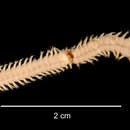en
names in breadcrumbs


“Neanthes abyssorum, new species
(Plate 16)
Record: 12:24 sta. 995 (6, TYPE).
Description: The body tapers posteriorly; it lacks color markings. Length exceeds 70 mm, width is 3 mm in the anterior third, and segments number more than 71. The prostomium is pentagonal and slightly longer than wide; it lacks eyes; the paired frontal antennae are about two-thirds as long as the prostomium. Palpi extend distally about as far as the antennae. Peristomial cirri number four pairs, with the longest more than twice as long as the prostomium ; all are smooth and taper distally. The peristomium is nearly twice as long as the first setigerous segment and closely wrinkled longitudinally. The dissected proboscis has inconspicuous paragnaths on both rings; areas I, II, IV, V, VII and VIII are bare; area III has six small cones in two rows arranged in a crescent ; area VI has about 16 very small cones in an oval patch ; the largest cones are on area III. jaws are dark horny brown ; each terminates distally in a long, slightly falcate tip and has five weak crenulations along the cutting edge.
Parapodia from the third segment are biramous, with notopodial, middle and neuropodial lobes well developed ; Fig. A shows a 14th parapodium. A typical one from a postmedian parapodium has equally long lobes (Fig. B) ; dorsal and ventral cirri are tapering and cirriform. Acicula are black, taper to slender tips and occur singly in a ramus. Notopodial setae are entirely composite, spinigerous, number four to ten.”
(Hartman, 1967)